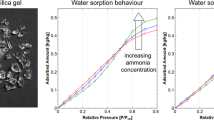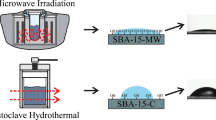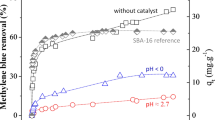Abstract
In this study, silica xerogels were synthesized via the method known in the literature. Various organic acids were used as catalyst while producing xerogels via Sol-gel method and the impact of these acids on xerogels’ surface area and hardness have been examined. 4 different organic acids (some of them were already mentioned in the literature) was selected, which are citric acid, oxalic acid, sulfanilic acid, and N-(2-hydroxyethyl)iminodiacetic acid. The characterization of the produced materials was performed by FTIR, whereas their surface area was measured through BET analysis. Their hardness were measured and calculated with a diamond-tipped microhardness device. The hardest material was the silica xerogel synthesized with N-(2-hydroxyethyl) iminodiacetic acid, whereas the material with lowest hardness was the one synthesized with oxalic acid. The silica xerogel with the largest surface area was the one with the highest hardness. The data indicated that the acid added during the synthesis reaction affect the hardness of the xerogel and hardness can be associated with pKa values of the added acids.
Similar content being viewed by others
References
Schuth F (2005) Engneered Porous catalytıc materıals. Annu Rev Mater Res 35:209–238
Adebajo MO, Frost RL, Kloprogge JT, Carmody O, Kokot S (2003) Porous materials for oil spill cleanup: a review of synthesis and absorbing properties. J Porous Mater 10:159–170
Valdes MG, Perez-Cordoves AI, Diaz-Garcia ME (2006) Zeolites and zeolite-based materials in analytical chemistry. Trends Anal Chem 25:24–30
Echeverria JC, Calleja I, Moriones P, Garrido JJ (2017) Fiber optic sensors based on hybrid phenyl-silica xerogel films to detect n-hexane: determination of the isosteric enthalpy of adsorption. Beilstein J Nanotechnol 8:475–484
Chen R, Qu R, Guo S, Ducheyne P (2015) The design and synthesis of a soluble composite silica xerogel and the short-time release of proteins. J Mater Chem B 3:3141–3149
Shea KJ, Loy DA (2001) Bridged polysilsesquioxanes. Molecular-engineered hybrid Organic−Inorganic materials. Chem Mater 13:3306–3319
Burleigh MC, Dai S, Hagaman EW, Lin JS (2001) Imprinted polysilsesquioxanes for the enhanced recognition of metal ions. Chem Mater 13:2537–2546
Kato M, Sakai-Kato K, Toyo’oka T (2005) Silica sol–gel monolithic materials and their use in a variety of applications. J Sep Sci 28:1893–1908
Gay DFS, Gushikem Y, Moro CC, Costa TMH, Benvenutti EV (2005) The effects of temperature of condensation on the thermal stability and morphology of 1,4-Phenylenediamine-1-Propylsilica xerogels. J Sol-Gel Sci Technol 34:189–195
Azolin DR, Celso CC, Costa TMH, Benvenutti EVB (2004) Effects of organic content and H 2 o/TEOS molar ratio on the porosity and pore size distribution of hybrid naphthaleneaminepropylsilica xerogel. J Non-Cryst Solids 337:201–206
Karmakar B, De G, Kundu D, Ganguli D (1991) Silica microspheres from the system tetraethyl orthosilicate-acetic acid-water. J Non-Cryst Solids 135:29–36
Liu Y, Ren W, Zhang L, Yao X (1999) Silica microspheres from the system tetraethyl orthosilicate-acetic acid-water. Thin Solid Films 353:124–128
Stathatos E, Lianos P, Orel B, Vuk AS, Jese R (2003) Study of acetic Acid-Catalyzed nanocomposite Organic/Inorganic ureasil Sol−Gel ionic conductors. Langmuir 19:7587–7591
Raman NK, Anderson MT, Brinker CJ (1996) Template-based approaches to the preparation of amorphous, nanoporous silicas. Chem Mater 8:1682–1701
Xiao FS (2005) Ordered mesoporous silica-based materials templated from fluorocarbon–hydrocarbon surfactant mixtures and semi-fluorinated surfactants. Curr Opin Colloid Interface Sci 10:94–101
Magnus P (1980) Organosilicon reagents for Carbon-Carbon bond forming reactions. Aldrichim Acta 13:43–57
Revuelta MV, van Raap MBF, Zélis PM, Sánchez FH, Castro GR (2011) Ascorbic acid encapsulation in hydrophobic silica xerogel. Food Technol Biotechnol 49:347–351
İbrahem S, İbrahem H (2013) Preparation and study properties of xerogel silica using sol-gel method. IJAIEM 2:111–116
Kulkarni MM, Bandyopadhyaya R, Bhattacharya B, Sharma A (2006) Microstructural and mechanical properties of silica–PEPEG polymer composite xerogels. Acta Mater 54:5231–5240
Gauthier BM, Bakrania SD, Anderson AM, Carroll MK (2004) A fast supercritical extraction technique for aerogel fabrication. J Non-Cryst Solids 350:238–243
Martin J, Hosticka B, Lattimer C, Norris PM (2001) Mechanical and acoustical properties as a function of PEG concentration in macroporous silica gels. J Non-Cryst Solids 285:222–229
Reetz MT, Zonta A, Simpelkamp J (1996) Efficient immobilization of lipases by entrapment in hydrophobic sol-gel materials. Biotechnol Bioeng 49:527–534
Venkastewara Rao A, Kulkarni MM (2003) Effect of glycerol additive on physical properties of hydrophobic silica aerogels. Mater Chem Phys 77:819–825
Anderson MT, Sawyer PS, Rieker T (1998) Surfactant-templated silica aerogels. Microporous Mesoporous Mater 20:53–65
Fidalgo A, Rosa ME, Ilharco LM (2003) Chemical control of highly porous silica xerogels: Physical properties and morphology. Chem Mater 15:2186–2192
Colomer MT, Anderson MA (2001) High porosity silica xerogels prepared by a particulate sol–gel route: pore structure and proton conductivity. J Non-Cryst Solids 290:93–104
Author information
Authors and Affiliations
Corresponding author
Rights and permissions
About this article
Cite this article
Kariper, İ.A. Impact of Organic Acids on the Hardness of Silica Xerogels. Silicon 11, 1159–1163 (2019). https://doi.org/10.1007/s12633-018-9901-5
Received:
Accepted:
Published:
Issue Date:
DOI: https://doi.org/10.1007/s12633-018-9901-5




